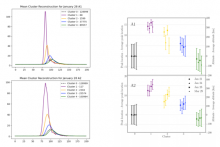
Abstract
We study individual pulses of Vela (PSR\ B0833-45\,/\,J0835-4510) from daily observations of over three hours (around 120,000 pulses per observation), performed simultaneously with the two radio telescopes at the Argentine Institute of Radioastronomy. We select 4 days of observations in January-March 2021 and study their statistical properties with machine learning techniques. We first use density based DBSCAN clustering techniques, associating pulses mainly by amplitudes, and find a correlation between higher amplitudes and earlier arrival times. We also find a weaker (polarization dependent) correlation with the mean width of the pulses. We identify clusters of the so-called mini-giant pulses, with ∼10× the average pulse amplitude. We then perform an independent study, with Self-Organizing Maps (SOM) clustering techniques. We use Variational AutoEncoder (VAE) reconstruction of the pulses to separate them clearly from the noise and select one of the days of observation to train VAE and apply it to thre rest of the observations. We use SOM to determine 4 clusters of pulses per day per radio telescope and conclude that our main results are robust and self-consistent. These results support models for emitting regions at different heights (separated each by roughly a hundred km) in the pulsar magnetosphere. We also model the pulses amplitude distribution with interstellar scintillation patterns at the inter-pulses time-scale finding a characterizing exponent nISS∼7−10. In the appendices we discuss independent checks of hardware systematics with the simultaneous use of the two radio telescopes in different one-polarization / two-polarizations configurations. We also provide a detailed analysis of the processes of radio-interferences cleaning and individual pulse folding.